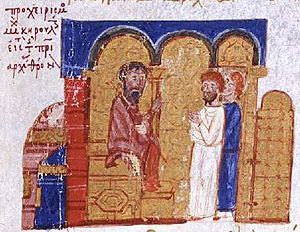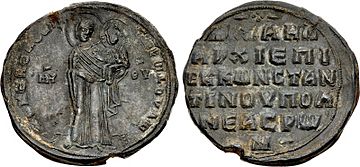Michael I Cerularius facts for kids
Quick facts for kids Michael I Cerularius |
|
|---|---|
| Ecumenical Patriarch of Constantinople | |

The enthronement of Michael I Cerularius, from the Madrid Skylitzes
|
|
| See | Constantinople |
| Enthroned | 1043 |
| Reign ended | 21 January 1059 |
| Predecessor | Alexius I Studites |
| Successor | Constantine III Lichoudas |
| Personal details | |
| Birth name | Michael Keroularios |
| Born | c. 1000 Constantinople, Byzantine Empire |
| Died | 21 January 1059 Constantinople, Byzantine Empire |
| Nationality | Byzantine |
| Denomination | Eastern Orthodoxy |
| Residence | Constantinople |
Michael I Cerularius (born around 1000 AD, died January 21, 1059 AD) was a very important leader in the Christian Church. He served as the Patriarch of Constantinople from 1043 to 1059. He is best known for his major role in the events that led to the Great Schism in 1054. This was a big split between the Eastern and Western branches of Christianity.
Contents
Who Was Michael Cerularius?
Michael Cerularius was born in Constantinople around the year 1000 AD. From a young age, he was trained to be a leader in the Church. He became the Patriarch of Constantinople, which is like being the top bishop in the Eastern Christian Church.
Early Church Role
Michael Cerularius often disagreed with Pope Leo IX, who was the leader of the Western Church in Rome. Their disagreements were about different ways of practicing Christianity. For example, they argued about using unleavened bread (bread without yeast) during the Eucharist, which is a holy ceremony.
Disagreements with the Pope
The disagreements between Michael Cerularius and Pope Leo IX were not just about bread. They also argued about bigger ideas. One major point was papal supremacy. This is the idea that the Pope in Rome should be the supreme leader of all Christians. Michael Cerularius did not agree with this.
They also argued about the filioque clause. This was a phrase added to the Nicene Creed in the Western Church. The Eastern Church believed this change was wrong. These differences, along with others, created tension between the two major Christian centers.
Letters and Authority
In 1054, Pope Leo IX sent a letter to Patriarch Michael. In this letter, the Pope claimed that the Bishop of Rome had the highest authority over all churches. He used an old document called the "Donation of Constantine" to support his claim. The Pope said this document proved his power.
However, Michael Cerularius did not accept the Pope's claims. He saw himself as an "ecumenical patriarch," meaning a universal leader. He addressed Pope Leo as "brother" instead of "father," which showed he saw them as equals, not one above the other.
The Great Schism of 1054
To try and resolve these issues, Pope Leo IX sent a group of official representatives to Constantinople. This group included Cardinal Humbert of Silva Candida. However, soon after they arrived, news came that Pope Leo had died. This made the representatives' position difficult, as their authority came from the Pope.
Despite this, they decided to continue their mission. But things quickly went wrong. Patriarch Michael refused to meet with them officially for months. The representatives then started to openly argue with the Patriarch.
Excommunication and Split
On July 16, 1054, Cardinal Humbert and his group took a very serious step. They went into the Hagia Sophia church during a service. There, they placed a document on the altar. This document was a Charter of Excommunication. It officially cut off Patriarch Michael and his followers from the Western Church.
Michael Cerularius reacted quickly. On July 20, 1054, he held a meeting with other bishops. This council decided to excommunicate Cardinal Humbert and his group in return. This meant they were cut off from the Eastern Church.
These events of 1054 caused the Great Schism. This was a major split that divided Christianity into two main branches: the Eastern Orthodox Church and the Roman Catholic Church. This split also ended the alliance between the Byzantine Emperor and the Pope.
In 1965, many centuries later, Pope Paul VI and Patriarch Athenagoras met in Jerusalem. They officially removed these old excommunications. This was an important step towards healing the relationship between the two churches.
Later Life and Challenges
After the Great Schism, Michael Cerularius continued to be a powerful figure. He even closed Latin churches in his area, which made the split worse.
He also became involved in politics within the Byzantine Empire. When Empress Theodora ruled, Michael disagreed with her. He felt that a woman should not govern the empire. A historian named Michael Psellos noted that Michael Cerularius spoke his mind freely about this.
Michael Cerularius also played a part in changing emperors. He helped convince Emperor Michael VI Stratiotikos to step down in 1057. This allowed a general named Isaac to become the new emperor, Isaac I Komnenos.
However, Michael Cerularius soon argued with Emperor Isaac I Komnenos. Their dispute was about church property. Michael even wore special purple shoes, which were usually only worn by the Emperor. This showed he might have wanted to take the throne himself or for a relative.
Because of this, Emperor Isaac exiled Michael to an island in 1058. Michael refused to give up his position as Patriarch. The Emperor then had accusations of heresy and treason prepared against him. However, Michael Cerularius died before he could be put on trial.
See also
 In Spanish: Miguel I Cerulario para niños
In Spanish: Miguel I Cerulario para niños


